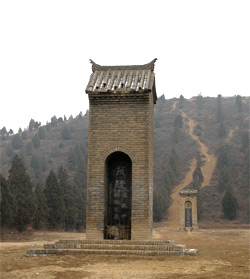The Maoling Mausoleum is located about 45 kilometers west of Xian City. The tomb is a huge green mound built among the mountains of shaanxi province. This is one of the largest tombs of over 20 Han Dynasty tombs in this region, and construction of it took over 50 years.
Emperor Wudi (140-87 BC) was buried here. The Maoling Mausoleum is also called the "Chinese Pyramid" because it is one of the largest tombs ever built, and it also contains some of the richest burial contents of all the mausoleums constructed during the Han Dynasty. It also took the longest time to built.
Emperor Wudi, born Liu Che, was the 6th emperor of the Han Dynasty, who was one of the most influencial emperors in Chinese History. He was crowned prince at age six, and ascended the throne at age sixteen. His influence and accomplishments are often compared with that of the first Emperor of China - Emperor Qin Shihuang.
During his reign, Emperor Wudi reserved the right to mint coins for the central government alone, and also established property tax on businesses. He established an Imperial college to train government officials. He also decreed that Confucianism should be the only accepted philosophy in China. Under Emperor Wudi's Reign, China prospered, and the prosperity of the Western Han Dynasty reached its highest peak during this period. It is also during this time period, that the famous Silk Road began.

The Maoling Mausoleum is a trapezoid shaped structure that is over 46 meters tall and 240 meters long. There are some remains of the city walls running 430 meters long and 6 meters wide. The tomb mound has a large flat base that narrows at the top.
The mausoleum grounds also include 20 smaller tombs that belong to favored court officials and concubines of the emperor. One of the more famous tombs here belonged to general Huo Qubing - a fierce general who fought multiple campaigns against northern Hun tribes. General Huo died at a young age of 24, and his tomb features many ceramic figurines, giant stone statues, and is considered one of the more splendid satellite tombs of Maoling
Construction of the Maoling Mausoleum began 139BC, in the second year after Emperor Wudi ascended the throne. This project would last 53 years. At the time of his death, the trees planted here grew so large that men could barely wrap their arms around the tree trunks. Historical records from the Han Dynasty indicated that the coffin chamber of the Maoling Mausoleum was filled with gold and treasures - it is believed that Emperor Wudi used about one third of the taxes he collected to build this tomb.
During the construction of the Mausoleum, the Maoxiang Township changed into Maoling County, and many wealthy and powerful people throughout China moved here.
The Maoling Museum covers an area of about 30 acres, and it has on display over 4,100 relics from the Western Han Dynasty. In 1981, over 230 pieces of relics were uncovered in the eastern satellite tombs which are also on display at the maoling museum.
|